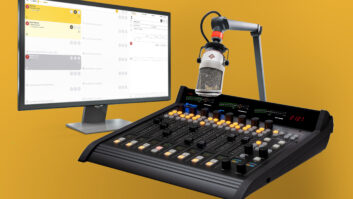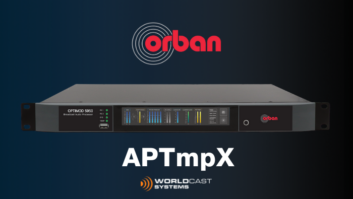(click thumbnail)The radio industry isn’t generally seen as a market for audiophile headphones.
The advent of CD and DAT media didn’t move the market, particularly, because no matter how clean the source material was, listeners still received it in processed analog. But now that all-digital audio paths are a reality — and with HD Radio creating a larger footprint — some radio people might be looking for better quality to monitor all that superior sound.
Unfortunately, no matter how good the headphones are, they must be driven by an amplifier, and few units on the market provide truly audiophile reproduction. It’s a problem Aphex Systems can relate to.
Although the company made its name with processing gear for studio and broadcast use — such as the Dominator II, Compellor and its flagship Aural Exciter line, as well as the Model 230 Master Voice Channel and the Model 2020 MkIII Broadcast Audio Processor — it has recently added other products.
Now in its catalog are D/A and A/D converters, a –10 to +4 level converter and the Anaconda bidirectional digital snake, which debuted at the 2006 AES Show.
Aphex is now in the headphone amplifier/splitter business, too, because the company found it hard to show off its processing gear with available headphone gear.
“Whenever we went to demo at trade shows, no matter what amplifiers we hauled around, we couldn’t get the quality we needed to properly demonstrate our products,” said Marvin Caesar, Aphex president and co-founder.
“So we created a circuit for our own use, just so we would have something good enough to monitor our processing products with. We started getting requests to put that circuit in a product that customers could buy.”
Functional real estate
That circuit became the Aphex HeadPod 454 professional high-output headphone box. It’s a rugged and functional device; a mighty midget that sounds great.
Straight out of the box, I saw that the HeadPod 454 is a serious piece of gear. Hefty for its size, the unit weighs in at 16 ounces for a box that’s smaller than a lot of digital field recorders (5.5 inches wide x 1.9 inches height x 4.5 inches deep), and is encased in metal. Not a plastic surface to be found. That alone makes it a standout product.
Layout is simple and functional: five knobs on the top — one master and four individual level controls — and four headphone jacks on the front. The back is just as straightforward. Feed the box either with a stereo TRS signal or individual left and right balanced signals, all on 1/4-inch tip-sleeve (TS) or tip-ring-sleeve (TRS) user-supplied cables. A switch selects between the stereo and individual inputs. There’s also a jack for the wall-wart AC supply.
Aphex has not neglected the bottom of the case. Where most manufacturers leave this blank, Aphex has screen-printed the specs, a graph showing maximum power output to the headphone jacks (expressed in ohms) and graphics showing the TRS and TS configurations for the input and output jacks. These days more non-technical people are being call on to connect things, so this is a helpful touch.
The HeadPod 454 is not only built for rugged simplicity, it’s a muscular audio device. In fact, the manufacturer has printed a warning right on the top of the case: “Caution: Turn down volume before plugging in.”
Yes, we’re all familiar with the disclaimers that lawyers insist upon to avoid lawsuits (“Caution: Do not touch hot part of iron with hand.”) But this is serious. The 454 packs a tremendous wallop.
Okay, so it’s rugged and loud, both prime considerations for a headphone distribution amp. But how does the HeadPod 454 perform with high-test audio?
This box sounds wonderful. Most headphone amps add something unwanted to the audio: hiss, distortion or crosstalk. We’re all used to it and, frankly, if you’re just listening to amped-up announcers and 20,000 wackos in a basketball arena, then who cares? The announcers are wearing sportscaster headsets. Volume rules. A $40 headphone amp might be just fine.
But for more discerning listeners with quality headphones, what works for remotes can be a major annoyance. If you’re monitoring jazz, classical or any digital music, distortion and hiss are unthinkable. For talk, too, it’s clarity that counts. Listener fatigue is something headphone makers addressed long before the amplifier folks.
With the HeadPod 454, critical monitoring can take place without having to crank the levels. The nuances of your audio source come out cleanly at modest levels, so you can listen longer and more comfortably.
How low can it go?
And then there’s the low end. That’s where lots of headphones and headphone amplifiers go off the rails.
“We recognized that even good headphones have problems with the bottom end. You don’t get a true response,” Caesar said. “If you listen to something that’s been mixed entirely through headphones, you almost always find that it’s bottom-heavy.”
Product CapsuleAphex HeadPod 454
Thumbs Up

- Clean sound, even at low frequencies and high volumes
- Excellent power without crosstalk or other noise
- Rugged construction, compact design
- High quality at lower volume cuts down on listener fatigue
Thumbs Down
- No way to mix or balance the left and right inputs
- No battery power/wasn’t designed for remotes
Price
$249 MSRP
Contact
Aphex Systems | 818-767-2929 | www.aphex.comPublished specs for the HeadPod 454 claim a frequency response of 10 Hz – 120 kHz, a breathtaking spectrum of sound. Total harmonic distortion plus noise is rated at <.001 percent at 100 mW into 25 ohms. Crosstalk is –80 at 1 kHz, –70 at 10 kHz. That makes what can be a very loud sound come out clean and clear.
I used the HeadPod 454 in my studio. At Caesar’s suggestion, I connected it straight into the regular headphone jack of my Mackie 1402VLZ Pro mixer. Mackie has always provided a clean and robust signal at the headphone jack, good enough to use for program output in a pinch. What the HeadPod 454 did was improve on what I had always thought of as a clean signal.
Listening through my Sony MDR-7506 headphones, the difference was obvious. It was crisp, clear and, unfortunately, brought out a couple of annoying room sounds I hadn’t noticed before.
Later, I tried a pair of Ultrasone Proline headphones and the improvement was astonishing. I had previously reviewed an Ultrasone headset for Radio World (“S-Logic Enables Audio Depth, Clarity,” Aug. 3, 2005) and knew that I could count on high-end, surround-sound type reproduction of any kind of music.
What I wasn’t prepared for was that clean low end referred to earlier. Caesar said this was the first thing a lot of trade show listeners noticed too, “the fact that they could finally hear the bottom end the way it’s supposed to sound. Even with great headphones, that wasn’t possible before.” It’s possible now.
This incredible sound comes at a price, naturally. The $249 MSRP might seem steep if you’re used to $39 headphone amps. But the pure quality and evident ruggedness make the HeadPod 454 a strong value in lots of ways. Mixes and program monitoring take a decided leap forward. And as I mentioned, this baby is rugged. You’re going to have it around for a long time.
At first look, the HeadPod 454 seems ideal for remotes as well as studio work. The construction and handy size are ideal. But, according to Caesar, the 454 isn’t designed for remotes, and while I would be tempted anyway, field use could be problematic due to the power supply. It’s a basic jack-in-the-back wall wart. Those little connectors are notoriously easy to disconnect accidentally in the field unless you tape them on and the unit does not have a battery option.
Another issue, and my only real complaint, is that you can’t mix or fade the left and right inputs, either the stereo or the independent left and right inputs. If you need different levels or balances from your inputs, such as for program return or cueing, you’ll have to bring them in from their own mono sources.
The Aphex HeadPod 454 fills a much-needed void in a world of end-to-end digital radio. It’s a strong performer and comes in such a convenient size that I can imagine engineers and even announcers, who insist on using their own headphones, carrying a HeadPod from shift to shift and station to station.












